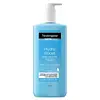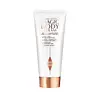What's inside
What's inside
 Key Ingredients
Key Ingredients

 Benefits
Benefits

 Concerns
Concerns

 Ingredients Side-by-side
Ingredients Side-by-side

Water
Skin ConditioningGlycerin
HumectantIsopropyl Palmitate
EmollientPetrolatum
EmollientCetyl Alcohol
EmollientDimethicone
EmollientSodium Hyaluronate
HumectantEthylhexylglycerin
Skin ConditioningCaprylyl Glycol
EmollientCetearyl Olivate
Sorbitan Olivate
EmulsifyingCarbomer
Emulsion StabilisingSodium Polyacrylate
AbsorbentSodium Hydroxide
BufferingTocopherol
AntioxidantPhenoxyethanol
PreservativeParfum
MaskingCI 42090
Cosmetic ColorantWater
Skin ConditioningGlycerin
HumectantCaprylic/Capric Triglyceride
MaskingGlyceryl Stearate Se
EmulsifyingTricaprylin
MaskingCoco-Caprylate/Caprate
EmollientSoybean Glycerides
EmollientCetyl Alcohol
EmollientButyrospermum Parkii Butter Unsaponifiables
Skin Conditioning1,2-Hexanediol
Skin ConditioningPentylene Glycol
Skin ConditioningMyristyl Myristate
EmollientPotassium Cetyl Phosphate
EmulsifyingCaprylyl Glycol
EmollientCarbomer
Emulsion StabilisingAcrylates/C10-30 Alkyl Acrylate Crosspolymer
Emulsion StabilisingCamellia Oleifera Seed Oil
Skin ConditioningRosa Canina Fruit Oil
EmollientSodium Gluconate
Skin ConditioningSodium Hydroxide
BufferingCaffeine
Skin ConditioningHelianthus Annuus Seed Oil
EmollientHaematococcus Pluvialis Extract
AntioxidantMaltodextrin
AbsorbentTocopherol
AntioxidantRosa Damascena Extract
MaskingSodium Hyaluronate
HumectantAscorbyl Palmitate
AntioxidantRosa Damascena Flower Oil
MaskingRosa Damascena Flower Water
MaskingMichelia Alba Leaf Oil
MaskingAloe Barbadensis Leaf Juice
Skin ConditioningPlumeria Rubra Flower Extract
Skin ConditioningCitric Acid
BufferingPotassium Sorbate
PreservativeSodium Benzoate
MaskingLinalool
PerfumingCitronellol
PerfumingGeraniol
PerfumingWater, Glycerin, Caprylic/Capric Triglyceride, Glyceryl Stearate Se, Tricaprylin, Coco-Caprylate/Caprate, Soybean Glycerides, Cetyl Alcohol, Butyrospermum Parkii Butter Unsaponifiables, 1,2-Hexanediol, Pentylene Glycol, Myristyl Myristate, Potassium Cetyl Phosphate, Caprylyl Glycol, Carbomer, Acrylates/C10-30 Alkyl Acrylate Crosspolymer, Camellia Oleifera Seed Oil, Rosa Canina Fruit Oil, Sodium Gluconate, Sodium Hydroxide, Caffeine, Helianthus Annuus Seed Oil, Haematococcus Pluvialis Extract, Maltodextrin, Tocopherol, Rosa Damascena Extract, Sodium Hyaluronate, Ascorbyl Palmitate, Rosa Damascena Flower Oil, Rosa Damascena Flower Water, Michelia Alba Leaf Oil, Aloe Barbadensis Leaf Juice, Plumeria Rubra Flower Extract, Citric Acid, Potassium Sorbate, Sodium Benzoate, Linalool, Citronellol, Geraniol
Ingredients Explained
These ingredients are found in both products.
Ingredients higher up in an ingredient list are typically present in a larger amount.
Caprylyl Glycol is a humectant and emollient, meaning it attracts and preserves moisture.
It is a common ingredient in many products, especially those designed to hydrate skin. The primary benefits are retaining moisture, skin softening, and promoting a healthy skin barrier.
Though Caprylyl Glycol is an alcohol derived from fatty acids, it is not the kind that can dry out skin.
This ingredient is also used as a preservative to extend the life of products. It has slight antimicrobial properties.
Learn more about Caprylyl GlycolCarbomer is a polymer of acrylic acid. Its main role is to create a gel consistency.
A high amount of carbomer can cause pilling or balling up of products. Don't worry, most products contain 1% or less of carbomer.
Cetyl Alcohol is a fatty alcohol. Fatty Alcohols are most often used as an emollient or to thicken a product.
Its main roles are:
Though it has "alcohol" in the name, it is not related to denatured alcohol or ethyl alcohol.
The FDA allows products labeled "alcohol-free" to have fatty alcohols.
Learn more about Cetyl AlcoholGlycerin is already naturally found in your skin. It helps moisturize and protect your skin.
A study from 2016 found glycerin to be more effective as a humectant than AHAs and hyaluronic acid.
As a humectant, it helps the skin stay hydrated by pulling moisture to your skin. The low molecular weight of glycerin allows it to pull moisture into the deeper layers of your skin.
Hydrated skin improves your skin barrier; Your skin barrier helps protect against irritants and bacteria.
Glycerin has also been found to have antimicrobial and antiviral properties. Due to these properties, glycerin is often used in wound and burn treatments.
In cosmetics, glycerin is usually derived from plants such as soybean or palm. However, it can also be sourced from animals, such as tallow or animal fat.
This ingredient is organic, colorless, odorless, and non-toxic.
Glycerin is the name for this ingredient in American English. British English uses Glycerol/Glycerine.
Learn more about GlycerinSodium Hyaluronate is hyaluronic acid's salt form. It is commonly derived from the sodium salt of hyaluronic acid.
Like hyaluronic acid, it is great at holding water and acts as a humectant. This makes it a great skin hydrating ingredient.
Sodium Hyaluronate is naturally occurring in our bodies and is mostly found in eye fluid and joints.
These are some other common types of Hyaluronic Acid:
Learn more about Sodium HyaluronateSodium Hydroxide is also known as lye or caustic soda. It is used to adjust the pH of products; many ingredients require a specific pH to be effective.
In small amounts, sodium hydroxide is considered safe to use. However, large amounts may cause chemical burns due to its high alkaline.
Your skin has a natural pH and acid mantle. This acid mantle helps prevent harmful bacteria from breaking through. The acid mantle also helps keep your skin hydrated.
"Alkaline" refers to a high pH level. A low pH level would be considered acidic.
Learn more about Sodium HydroxideTocopherol (also known as Vitamin E) is a common antioxidant used to help protect the skin from free-radicals and strengthen the skin barrier. It's also fat soluble - this means our skin is great at absorbing it.
Vitamin E also helps keep your natural skin lipids healthy. Your lipid skin barrier naturally consists of lipids, ceramides, and fatty acids. Vitamin E offers extra protection for your skin’s lipid barrier, keeping your skin healthy and nourished.
Another benefit is a bit of UV protection. Vitamin E helps reduce the damage caused by UVB rays. (It should not replace your sunscreen). Combining it with Vitamin C can decrease sunburned cells and hyperpigmentation after UV exposure.
You might have noticed Vitamin E + C often paired together. This is because it is great at stabilizing Vitamin C. Using the two together helps increase the effectiveness of both ingredients.
There are often claims that Vitamin E can reduce/prevent scarring, but these claims haven't been confirmed by scientific research.
Learn more about TocopherolWater. It's the most common cosmetic ingredient of all. You'll usually see it at the top of ingredient lists, meaning that it makes up the largest part of the product.
So why is it so popular? Water most often acts as a solvent - this means that it helps dissolve other ingredients into the formulation.
You'll also recognize water as that liquid we all need to stay alive. If you see this, drink a glass of water. Stay hydrated!
Learn more about Water